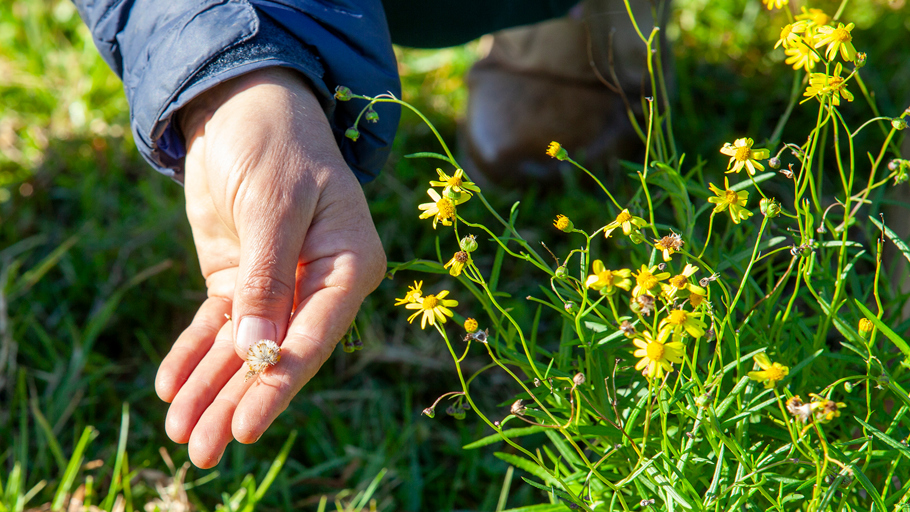Madagascar ragwort – A major threat to pastoral farming
Madagascar ragwort (Senecio madagascariensis) is a pasture weed that is rapidly spreading in Northland. It is likely to become the most serious threat to pastoral farming in New Zealand.
Prevention, early detection and intervention is the best way to protect your farm or lifestyle block and reduce the impact of Madagascar ragwort on your farm and your neighbours.
There are several factors that make Madagascar ragwort a much more significant threat than other pasture weeds.
- Major impact on pasture: Stock avoid grazing near it, creating a ‘shadow effect’. This enables Madagascar ragwort to spread further and increases pasture loss. There are documented declines in production of 35% and losses of more than $500 per hectare annually.
- Dangerous to stock: It’s poisonous – and can be fatal – to stock, remaining toxic even in hay or silage, with no treatment available for affected animals.
- Establishes easily and rapidly: A single adult plant can produce 10,000 seeds within six weeks of germination. It can germinate all year round following warm rain events. Seeds drop relatively close to the parent plant however they can be blown long distances by wind.
- Difficult and costly to control: There is no single approach that effectively controls Madagascar ragwort at all life stages. A combination of pasture improvement and management, plus repeated and carefully timed intensive herbicide controls are usually required to control well-established infestations.
It has yellow, daisy-type flowers (1-2cm diameter), which can be present year-round, but are most common in autumn and spring. Leaf size and shape varies but are usually narrow (2–7 cm), with finely toothed edges.
Madagascar ragwort can look identical to gravel groundsel (Senecio skirrhodon), however gravel groundsel is more restricted to roadsides, gravelly/sandy areas and other disturbed sites. If it is growing in pasture it is much more likely to be Madagascar ragwort.
Check out the Madagascar ragwort Pest Control Hub page for further photos and a guide to distinguishing it from gravel groundsel.
 Juvenile Madagascar ragwort plant
Juvenile Madagascar ragwort plant
 Madagascar ragwort leaves and stems
Madagascar ragwort leaves and stems
 Madagascar ragwort (close-up) growing in pasture
Madagascar ragwort (close-up) growing in pasture
 Madagascar Ragwort flowers held between fingers
Madagascar Ragwort flowers held between fingers
 Gravel groundsel (Senecio skirrhodon) (left), with bracts wider than the 0.8mm wide metal tool. Madagascar ragwort (Senecio madagascariensis) (right) with bracts the same width or smaller than the 0.8mm wide metal tool.
Gravel groundsel (Senecio skirrhodon) (left), with bracts wider than the 0.8mm wide metal tool. Madagascar ragwort (Senecio madagascariensis) (right) with bracts the same width or smaller than the 0.8mm wide metal tool.
 How to identify Madagascar ragwort (Senecio madagascariensis) (top) compared to gravel groundsel (Senecio skirrhodon) (bottom)
How to identify Madagascar ragwort (Senecio madagascariensis) (top) compared to gravel groundsel (Senecio skirrhodon) (bottom)

Madagascar ragwort is currently widespread in the Far North, and is spreading rapidly in the mid-North. The current southern edge for confirmed infestations is Pakaraka, Kaikohe and Waima in the Hokianga.
Its distribution is likely to be significantly underestimated. As Madagascar ragwort looks identical to the widespread weed gravel groundsel (Senecio skirrhodon), early invasions into new areas are more likely to go unnoticed.
Evidence from overseas and climate modelling indicate that most of the North Island would be vulnerable to invasion, as well as large areas of the South Island.
Madagascar ragwort distribution in Northland

The scale of this issue requires a coordinated, joint approach between central government, regional councils, and industry. We are working with DairyNZ, Beef + Lamb New Zealand, and Pāmu Farms to fund the development of a business case that outlines the potential economic impact of Madagascar ragwort and agreed priorities for its long-term management and further research.
There is currently no ‘silver bullet’ for controlling this weed. Council has commissioned two research reports that outline the next steps for biological control research and agrichemical control research, and we are seeking support to progress these:
To prevent Madagascar ragwort from accidentally reaching your farm , or lifestyle block, following good farm biosecurity practices is essential. This includes:
- Making sure all machines are clean on arrival.
- Keeping new stock in a quarantine paddock near the yards for the first 24 hours.
- Making sure seeds and fodder crops are from clean sources.
- After visiting other sites, clean the vehicle underside and tyres near the shed.
Spread the word – help make others in your community aware of Madagascar ragwort so they can also be vigilant and act early if required.
Keep searching for before it becomes fully established and know how best to control it.
If you already have significant amounts of Madagascar ragwort on your farm talk to your rural supplier’s Technical Advisor for the best control and management advice for your specific situation, or check out the Madagascar ragwort Pest Control Hub page.
If you think you have seen it south of Pakaraka, Kaikohe and Waima in the Hokianga, call us on 0800 002 004 or email info@nrc.govt.nz
For more information, visit the Madagascar ragwort Pest Control Hub page.
